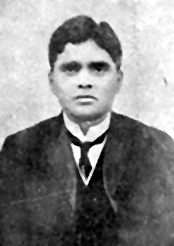Top Qs
Timeline
Chat
Perspective
Tanguturi Prakasam
Chief Minister of Andhra State from 1953 to 1954 From Wikipedia, the free encyclopedia
Remove ads
Tanguturi Prakasam (23 August 1872 – 20 May 1957), popularly known as Prakasam Panthulu, was an Indian jurist, political leader, social reformer, and anti-colonial nationalist who was the premier of the Madras Presidency from 1946 to 1947, before serving as the chief minister of the erstwhile Andhra State, from 1953 to 1954. Prakasam was known as "Andhra Kesari" which translates to "Lion of Andhra". In 2014, the state government of Andhra Pradesh declared his birth anniversary to be a state function.
Remove ads
Early life

Tanguturi Prakasam was born on 23 August 1872 in Vinodarayunipalem, Madras Presidency, British India, to a Brahmin family.[1][2] Following the death of his father when he was eleven years old, his mother assumed responsibility for financial support. The family then moved to Rajahmundry.[3]
He moved to the United Kingdom in 1904 to pursue his higher education and qualified as a barrister, before returning to India to practice law. However, he later quit his profession to work as an editor of the Swarajya, a conservative and center-right publication at the time, under the patronage of C. Rajagopalachari.[3][4]
Remove ads
Role in the Indian independence movement
Summarize
Perspective

Affiliated with the Indian National Congress (INC; often simply known as the Congress), Prakasam was elected as the president of the Andhra Region Congress Committee in 1921.
In 1928, the Simon Commission, a delegation of seven members of the British Parliament chaired by John Simon, arrived in British India to assess and recommend proposals for constitutional reform. The commission’s arrival was met with widespread opposition across the Indian subcontinent, including protests, strikes, and civil disobedience, although it did receive limited support. The opposition was notably marked by the slogan "Simon Go Back." Among the prominent figures opposing the commission was Prakasam. In a widely recognised act of defiance, Prakasam reportedly exposed his chest to armed police, daring them to open fire on him, during the commission's visit to Madras. This gesture earned him the epithet Andhra Kesari, meaning "Lion of Andhra."[3][5]
In response to Mahatma Gandhi’s call to oppose the British salt monopoly in 1930, Prakasam led a Salt March from the village of Devarampadu. This action was undertaken in coordination with Gandhi’s Dandi March.[6]

Prakasam served as the Revenue Minister in the cabinet of C. Rajagopalachari during the latter's tenure as Premier of the Madras Presidency from 1937 to 1939. In this capacity, he produced a comprehensive report advocating for the abolition of the Zamindari system. Following his success in the 1946 Madras Presidency Legislative Assembly election, he assumed office as Premier of the Madras Presidency. However, he resigned in 1947 due to an internal party rebellion. The Zamindari system was legally abolished in the state in 1948.[7]
Remove ads
Post-independence activities
Summarize
Perspective

By 1946, Prakasam had emerged as a significant dissenting figure within the Congress. In the Andhra region, the party was internally divided into two factions, one led by Bhogaraju Pattabhi Sitaramayya and supported by Kala Venkata Rao and Neelam Sanjiva Reddy, the other led by Prakasam and supported by N. G. Ranga, Tenneti Viswanadham, and Gouthu Latchanna. In May 1951, Prakasam and Ranga formally parted ways with the Congress and established the Praja Party. Around the same period, at the national level, dissidents led by J. B. Kripalani, who held ideological disagreements with Prime Minister Jawaharlal Nehru, broke away from the Congress to form the Kisan Mazdoor Praja Party (KMPP). Subsequently, the Praja Party merged with the KMPP later that year.[8]
In 1952, the KMPP merged with the Socialist Party to create the Praja Socialist Party (PSP) at the national level. Prakasam assumed leadership of the PSP's unit in the Madras State. However, in the Andhra region, the party continued to maintain its distinct earlier identity. In 1953, it was reconstituted by Prakasam as the Praja Party, functioning independently of the national PSP. Following the formation of the Andhra state in October 1953, the regional Praja Party merged with the local unit of the Socialist Party to form the Andhra branch of the Praja Socialist Party, led again by Prakasam.[8][7]
Chief Minister of Andhra State (1953–1954)
Summarize
Perspective

In the newly established Andhra State, no single political party achieved a majority in the legislative assembly, necessitating the formation of a coalition government. Upon the recommendation of the Congress, Prakasam was appointed as the Chief Minister on the day of the state's inception. He subsequently led a Congress-backed administration, a development that attracted considerable criticism from various quarters. Prakasam's return to the Congress, led to significant tensions among parties, notably resulting in the PSP, both at the national and state level, refusing to participate in Prakasam's coalition government.[8]
On 15 November 1954, the opposition successfully passed a motion of no confidence against Prakasam's administration, resulting in its collapse by a narrow margin of one vote. Following the fall of the government, the Andhra State Legislative Assembly was dissolved, and President's rule was imposed, until the 1955 Andhra State Legislative Assembly election, in which the Congress secured a landslide victory. Bezawada Gopala Reddy, representing the Congress, was subsequently elected Chief Minister.[8]
Remove ads
Death and legacy

Prakasam died on 20 May 1957, in Hyderabad, Andhra Pradesh, after a brief illness.[7]
In 1972, the Ongole district of Andhra Pradesh was renamed to Prakasam district in his memory.[9] In 2014, the state government of Andhra Pradesh declared his birth anniversary a state function.[10]
See also
References
Wikiwand - on
Seamless Wikipedia browsing. On steroids.
Remove ads

